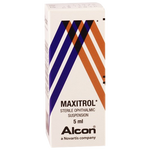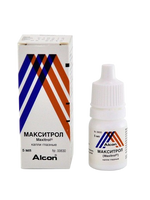MAXITROL EYE DROPS
- International Name: MAXITROL
- Pharmacological group: Antimicrobial drugs
- Manufacturer: Alcon
- Country: Belgium
- Issuance form: Group III over-the-counter
International name: DEXAMETHAZONE; NEOMTCIN; POLYMYXIN B
Manufacturer: ALKON, Belgium
Clinical-pharmacological group: combined antibacterial and anti-inflammatory drug for local use in ophthalmology.
Composition and release form:
Eye suspension: 5 ml drop-tainer with a dropper in a plastic bottle.
1 fl.
Dexamethasone ....................... 1 mg
Neomycin sulfate.............. 3.5 mg
Polymyxin B sulfate............6000 IU
Preservative - benzalkonium chloride............0.004%
Base-Hydroxypropylmethylcellulose ...........0.5%
Eye ointment: 3.5 g in a tube
1 g
Dexamethasone ................................ 1 mg
Neomycin sulfate ...................... 3.5 mg
Polymyxin B sulfate ................ 6000 IU
Preservatives :
Methylpraben.........0.05%
Propylparaben.....0.01%
Neutral substances :
White Vaseline, Anhydrous Liquid Lanolin
Pharmacological properties:
Maxitrol (dexamethasone 0.1%, neomycin sulfate, polymyxin B sulfate) is an anti-inflammatory and antimicrobial drug for local use in the form of a sterile suspension and ointment.
Ophthalmic drug Maxitrol contains two broad- spectrum antibiotics in combination with a corticosteroid, which allows the treatment of bacterial infections of the anterior segment of the eye.
Corticosteroids suppress the inflammatory response, however, they may inhibit the wound-healing process, since they are known to have the ability to weaken the body's defense mechanisms in certain cases. Antimicrobial agents should be prescribed at this time.
Antimicrobial ingredients contained in the drug act on the following microorganisms: neomycin sulfate - Staphylococcus aureus, Escherichia coli, Klebsiella pneumoniae, Haemophilus influenza;
Polymyxin В is active against gram-negative bacteria: Escherichia coli, Klebsiella pneumoniae, Haemophilus influenzae, and Pseudomonas aeruginosa.
Resistant to this antibiotic: Streptococcus spp., including Streptococcus pneumoniae, and anaerobic bacteria
A combination of corticosteroids and antibiotics is more practical for patients. The relative activity of corticosteroids depends on their molecular structure.
Indications:
- Maxitrol is used in inflammatory processes of the eye when it is necessary to carry out joint antimicrobial and glucocorticoid therapy.
Rules of administration and dosage:
Maxitrol suspension:
1-2 drops in the eye. In acute forms of the disease, it can be dripped every 1 hour. As the condition improves, the frequency of taking the drug decreases until it is completely removed.
During prolonged processes, it is prescribed 4-5 times a day.
Maxitrol ointment is applied 3-4 times a day.
Side effects:
Allergic reactions - related to increased sensitivity to the ingredients included in the drug;
increased intraocular pressure, rarely - subcapsular cataract;
Delay in wound healing, secondary infections.
Contraindications :
* keratitis caused by herpes simplex;
* a number of viral diseases of the cornea and conjunctiva;
* fungal eye diseases;
* Increased sensitivity to any component of the drug;
* The drug is categorically contraindicated when removing a foreign body from the cornea.
Special instructions :
* In case of long-term use, it is possible to develop glaucoma, damage to the optic nerve, decrease in visual acuity, reduce the field of vision, as well as further development of subcapsular cataract.
* Continued use can suppress the patient's immune system, which increases the risk of secondary infection.
* During acute purulent processes of the eye, the drug can mask or complicate the course of the infectious process. If corticosteroids are used for more than 10 days, regular monitoring of intraocular pressure is required.
Storage conditions :
The drug is stored at room temperature, in a place protected from children.
Conditions of release: Out of prescription.




